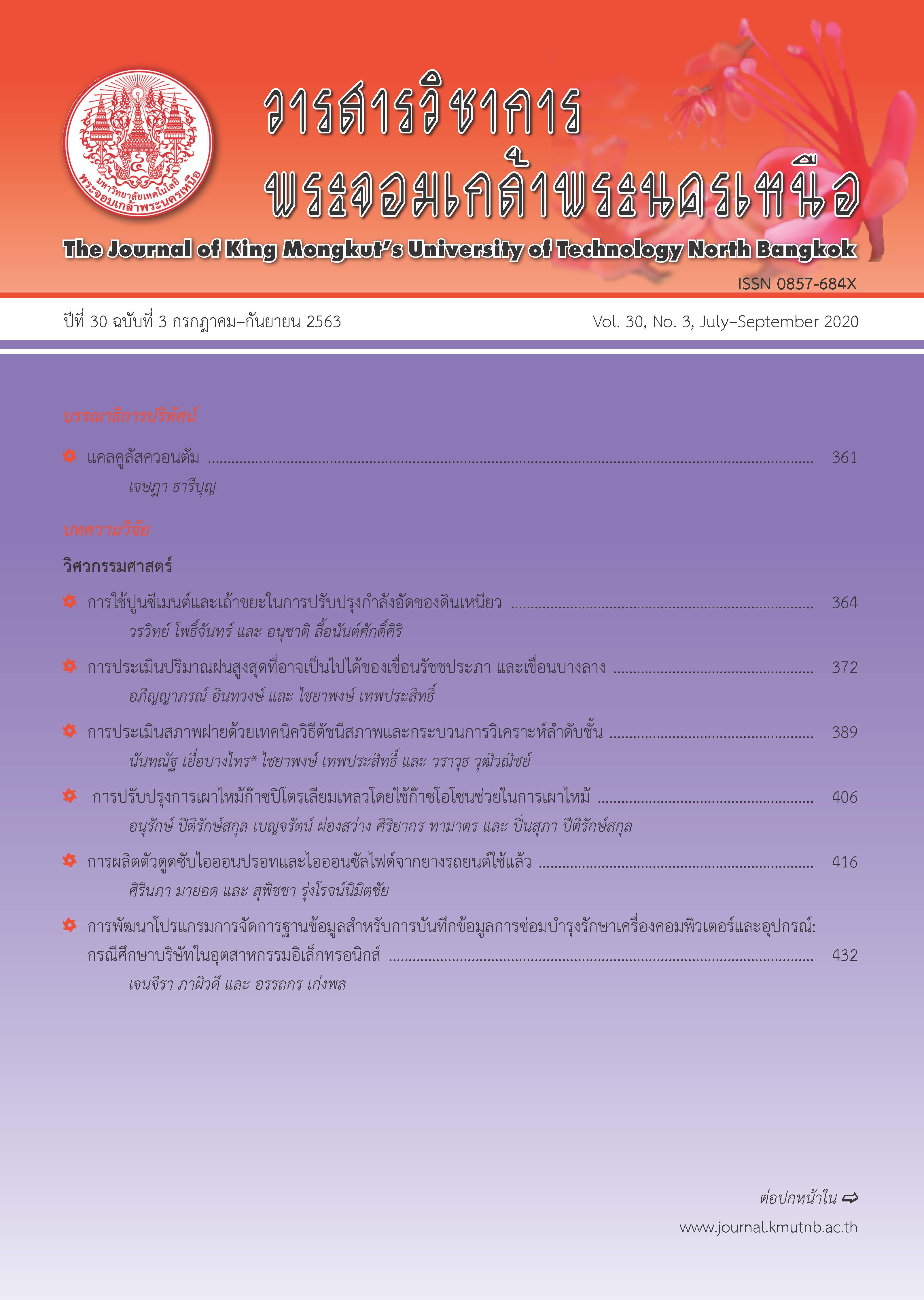การผลิตตัวดูดซับไอออนปรอทและไอออนซัลไฟด์จากยางรถยนต์ใช้แล้ว
Main Article Content
บทคัดย่อ
ยางรถยนต์ใช้แล้วมีแนวโน้มที่จะก่อให้เกิดปัญหามลภาวะเนื่องจากยางรถยนต์ใช้แล้วมีปริมาณเพิ่มสูงขึ้นทุกปี และยังเป็นวัสดุที่ยากต่อการย่อยสลายตามธรรมชาติ งานวิจัยนี้จึงได้นำยางรถยนต์ใช้แล้วมาดัดแปรด้วยปฏิกิริยาออกซิเดชันโดยใช้กรดไนตริกเข้มข้นและโซเดียมไนไตรท์ความเข้มข้นร้อยละ 1 โดยมวลต่อปริมาตร เพื่อใช้เป็นตัวดูดซับไอออนปรอทและไอออนซัลไฟด์โดยยางรถยนต์ใช้แล้วถูกดัดแปรที่อุณหภูมิ 30 องศาเซลเซียส เป็นเวลา 4 ชั่วโมง มีการเปลี่ยนแปลงปริมาตรกรดไนตริกตั้งแต่ 20 ถึง 40 มิลลิลิตร พบว่า สภาวะที่เหมาะสมคือ การใช้ปริมาตรกรดไนตริกเท่ากับ 35 มิลลิลิตร ซึ่งให้ตัวอย่างที่มีปริมาณคาร์บอกซิลสูงที่สุด (1.26 มิลลิโมลต่อกรัม) เมื่อวิเคราะห์ลักษณะสัณฐานด้วยภาพถ่าย SEM พบว่า พื้นผิวของยางรถยนต์ใช้แล้วดัดแปรมีรูพรุนมากกว่าวัตถุดิบยางรถยนต์ใช้แล้ว ผลการวิเคราะห์พื้นที่ผิวจาก BET พบว่า ยางรถยนต์ใช้แล้วดัดแปรมีพื้นที่ผิวมากกว่าวัตถุดิบยางรถยนต์ใช้แล้วถึง 215 เท่า ผลการวิเคราะห์ปริมาณธาตุ %C, H, N, S และ O แสดงให้เห็นว่าปริมาณธาตุออกซิเจนเพิ่มขึ้นหลังจากการดัดแปร การวิเคราะห์ด้วยเทคนิค FT-IR พบว่า หมู่คาร์บอกซิลหรือหมู่คาร์บอนิลเกิดขึ้นหลังการทำปฏิกิริยาออกซิเดชัน ความสามารถในการดูดซับไอออนปรอท (Hg2+) ของวัตถุดิบยางรถยนต์ใช้แล้ว และยางรถยนต์ใช้แล้วดัดแปรที่คำนวณได้จากแลงเมียร์ไอโซเทอมมีค่าเท่ากับ 7.07 และ 4.33 มิลลิกรัมต่อกรัม และความสามารถในการดูดซับไอออนซัลไฟด์ (S2-) มีค่าเท่ากับ 22.47 และ 123.46 มิลลิกรัมต่อกรัม ตามลำดับ
Article Details
บทความที่ลงตีพิมพ์เป็นข้อคิดเห็นของผู้เขียนเท่านั้น
ผู้เขียนจะต้องเป็นผู้รับผิดชอบต่อผลทางกฎหมายใดๆ ที่อาจเกิดขึ้นจากบทความนั้น
เอกสารอ้างอิง
[2] N. J. Langford and R.E. Ferner, “Toxicity of mercury,” Journal of Human Hypertension, vol. 13, pp. 651–656, 1999.
[3] N. Srimuang. (2017, August). Minamata disease is the biggest disaster in Japan. The Institute for the Promotion of Teaching Science and Technology. Bangkok, Thailand. [Online]. Available: https://www.scimath.org/articlechemistry/item/7387-2017-07-20-07-30-13
[4] A. Shafeeq, A. Muhammad, W. Sarfraz, A. Toqeer, S. Rashid, and M.K. Rafiq, “Mercury removal techniques for industrial waste water,” International Journal of Environmental and Ecological Engineering, vol. 6, no. 12, pp. 1164–1167, 2012.
[5] T. Palmer, P. Lagasse, and M. Ross. (2000, December). Hydrogen sulfide control in wastewater collection systems. Instrumentation Testing Association (ITA). Henderson, United States. [Online]. Available: https://www.wwdmag.com/decentralized-wastewater/hydrogen-sulfide-control-wastewater-collectionsystems
[6] Ramathibodi Poison Center. (2013, July). Hydrogen sulfide. Mahidol University. Bangkok, Thailand. [Online]. Available: https://med.mahidol.ac.th/poisoncenter/th/pois-cov/gas/Hydrosul
[7] S. Edwards, R. Alharthi, and A.E. Ghaly, “Removal of Hydrogen Sulphide from Water,” American Journal of Environmental Sciences, vol. 7, no. 4, pp. 295–305, 2011.
[8] Mining Waste Team, Chemical Precipitation. Interstate Technology & Regulatory Council., Washington, DC, 2010, pp. 1–9.
[9] E. Hassinger, T.A. Doerge, and P.B. Baker. (1994, February). Water facts: number 6 reverse osmosis units. The University of Arizona. Arizona, United States. [Online]. Available: https://water-research.net/Waterlibrary/privatewell/reverseosmosis.pdf
[10] J. Brennan. (2017, April). Ozone water treatment disadvantages. Sciencing. California, United States. [Online]. Available: https://sciencing.com/ozone-water-treatment-disadvantages-22555.html
[11] G. Crini and E. Lichtfous, “Advantages and disadvantages of techniques used for wastewater treatment,” Environmental Chemistry Letters, vol. 17, pp. 145–155, 2019.
[12] K. Formela, A. Hejna, Ł. Zedler, X. Colom, and J. Cañavate, “Microwave treatment in waste rubber recycling – recent advances and limitations,” eXPRESS Polymer Letters, vol. 13, no. 6, pp. 565–588, 2019.
[13] C. Sathiskumar and S. Karthikeyanb, “Recycling of waste tires and its energy storage application of by-products-a review,” Sustainable Materials and Technologies, vol. 22, pp. 1–6, 2019.
[14] A. Siddika, A.A. Mamun, R. Alyousef, M. Amran, F. Aslani, and H. Alabduljabbar, “Properties and utilizations of waste tire rubber in concrete: A review,” Construction and Building Materials, vol. 224, pp. 711–731, 2019.
[15] Y. Li, S. Zhang, R. Wang, and F. Dang, “Potential use of waste tire rubber as aggregate in cement concrete-A comprehensive review,” Construction and Building Materials, vol. 225, pp. 1183–1201, 2019.
[16] K. A. Dubkov, S. V. Semikolenov, D. P. Ivanov, D. E. Babushkin, G. I. Panov, and V.N. Parmon, “Reclamation of waste tyre rubber with nitrous oxide,” Polymer Degradation and Stability, vol. 97, pp. 1123–1130, 2012.
[17] F. Cataldo, O. Ursini, and G. Angelini, “Surface oxidation of rubber crumb with ozone,” Polymer Degradation and Stability, vol. 95, pp. 803–810, 2010.
[18] L. He, Y. Ma, Q. Liu, and Y. Mu, “Surface modification of crumb rubber and its influence on the mechanical properties of rubbercement concrete,” Construction and Building Materials, vol. 120, pp. 403-407, 2016.
[19] K. Yu, H. Wang, H. Han, R. Li, X. Chen, J. Du, W. Quan, and S. Liu, “Hydrogen peroxide oxidizing modification of crumb tire rubber and its application in modified bitumen,” Journal of Tianjin University Science and Technology, vol. 47, pp. 949–954, 2014.
[20] F. Bernard, M. Cazaunau, Y. Mu, X. Wang, V. Daële, J. Chen, and A. Mellouki, “Reaction of NO2 with selected conjugated alkenes,” The Journal of Physical Chemistry A, vol. 117, pp. 14132−14140, 2013.
[21] S. Rungrodnimitchai, S. Mayod, and S. Tanasarn, “The utilization of ground tire rubber as ion exchange materials,” Defect and Diffusion Forum, vol. 382, pp. 352–356, 2018.
[22] E. Manchon-Vizuete´, A. Mac´ıas-Garc´ıa, A.N. Gisbert, C. Fernandez-Gonz´ alez´, and V. Gomez-Serrano, “Adsorption of mercury by carbonaceous adsorbents prepared from rubber of tyre wastes,” Journal of Hazardous Materials, vol. 119, no. 1–3, pp. 231–238, 2005.
[23] M.J. Fishman and L.C. Friedman, “Methods for the determination of inorganic substances in water and fluvial sediments,” in Techniques of Water-Resources Investigations of the United States Geological Survey, 3rd ed. California, Geological Survey (U.S.), 1989, ch. 1, sec. xii, pp. 545.
[24] I. Langmuir, “The constitution and fundamental properties of solids and liquids. Part I. solids,” Journal of the American Chemical Society, vol. 38, no. 11, pp. 2221–2295, 1916.
[25] H. Freundlich, “Über die adsorption in lösungen,” Zeitschrift für Physikalische Chemie, vol. 57, no. 1, pp. 385–470, 1906.
[26] M.A. Hossain, H.H. Ngo, W.S. Guo, and T. Setiadi, “Adsorption and desorption of copper(II) ions onto garden grass,” Bioresource Technology, vol. 121, pp. 386–395, 2012.
[27] C. Troca-Torrado, M. Alexandre-Franco, C. Fernández-González, M. Alfaro-Domínguez, and V. Gómez-Serrano, “Development of adsorbents from used tire rubber their use in the adsorption of organic and inorganic solutes in aqueous solution,” Fuel Processing Technology, vol. 92, pp. 206–212, 2011.
[28] V. Eychenne and Z. Mouloungui, “Convenient thionation of triglycerides with lawessons reagent,” Journal of the American Oil Chemists' Society, vol. 78, no. 3, pp. 229–234, 2001.
[29] O. Leelapodjanaporn. (2003, October). Fourier transform infraRed Spectrometer. Department of Science Service. Bangkok, Thailand. [Online]. Available: http://siweb.dss.go.th/dss_doc/dss_doc/show_discription_doc.asp?ID=4
[30] H.C. Hsi, M.J. Rood, M. ASCE, M. Rostam-Abadi, S. Chen, and R. Chang, “Mercury adsorption properties of sulfur-impregnated Adsorbents,” Journal of Environmental Engineering, vol. 128, no. 11, pp. 1080–1089, 2002.
[31] P. Danwanichakul, D. Dechojarasrri, S. Meesumrit, and S. Swangwareesakul, “Influence of sulfurcrosslinking in vulcanized rubber chips on mercury(II) removal from contaminated water,” Journal of Hazardous Materials, vol. 154, pp. 1–8, 2008.
[32] B.M. Trost and I. Fleming, Comprehensive organic synthesis, 5th ed. Oxford, UK: Elsevier, 2005, pp. 1015–1044.
[33] M. Harmata, “Nucleophilic substitution reactions at the carboxyl carbon,” Organic Mechanisms, Berlin, Germany: Springer, 2010, ch. 6, pp. 259-320.

